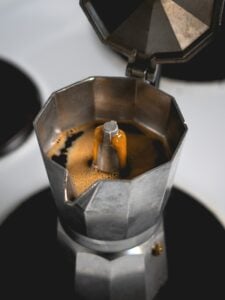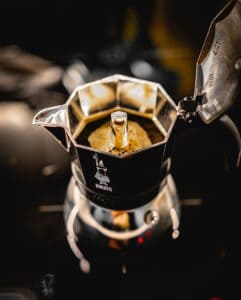How to Use a Moka Pot Properly (Step By Step Guide)

Table of Contents
ToggleThe moka pot is one of the most traditional, simple and effective ways to brew strong, espresso-like coffee in minutes.
Born in the home of European coffee, Italy, the Moka pot has become a staple across Italian households as the coffee brewer of choice.
So, should you invest in a moka pot yourself? Is it really worth changing from a French Press or pour over to start using a moka pot? Well, let’s find out!
What is a Moka Pot?

A moka pot is a small coffee brewing device that sits on a stovetop and uses the heat to push pressurized, boiling water through ground coffee. This results in a strong, espresso-like coffee from this inexpensive device. Multiple chambers are used to separate the hot water at the bottom, the coffee basket in the middle, and the coffee collection chamber at the top.
In terms of how a Moka pot operates, it is more similar to an espresso machine or a percolator in the way it uses built up pressure and hot water to drive steam through finely ground coffee.
However, where an espresso machine uses gravity and a downwards flow of hot water to extract coffee from the beans, a Moka pot works in the opposite direction.
Water is added to the bottom chamber of the Moka pot, with fine to medium ground coffee placed in the filter basket which sits on top. Then, the coffee collection chamber is screwed on tightly and the whole thing is placed over a hot stovetop.
The stove heats the bottom of the Moka pot (made from aluminum) which then further boils the hot water above. This generates steam which, as the water boils over, rapidly evaporates through the coffee grounds and pushes hot coffee up through the central spout of the coffee collection chamber.
You’ll know your coffee is done when you can hear the gurgling and hissing of the coffee being driven up through the middle of the Moka pot.
Where Did the Moka Pot Come From?
According to the Moka pot Wikipedia page, the device was first invented in 1933 by Italian designer Alfonso Bialetti, of Bialetti Industries. It then became a staple in Italian kitchens and soon spread throughout Europe.
European migrants (who had been displaced due to the second world war), brought their Moka pots to parts of South America and Australia, further spreading the usage of the device.
You may be wondering where the Moka pot gets its name…
Well, the Moka pot was named after the city of Mocha, in Yemen. Mocha has a rich history of being one of the original coffee trading ports and even drinks like the mocha are thought to also be named after the coastal city.
How to Use a Moka Pot: Step by Step
If you have never used a Moka pot before and are now thinking of making the switch from your current coffee brewer of choice, check out this step by step guide below.
Step 1: Grind Your Coffee Beans
The first step to take when using a Moka pot is to grind your coffee beans.
Since the Moka pot uses pressurized steam to extract coffee from the beans themselves, you’ll want to use a relatively fine grind size.
I recommend using a medium to fine grind for Moka pot coffee, which sits somewhere between an espresso grind and a pour over grind.
This will ensure you have a fine enough grind to achieve full extraction, but not too fine that you risk over extraction and bitterness in your brew.
In terms of the quantity of coffee needed, you need to pretty much fill up your moka pot basket. A rough rule of thumb is 20g/0.7 Oz per cup of coffee brewed.
However, filling up your basket to the predetermined quantity of coffee along with the ready made water chamber will make sure you get the right coffee to water ratio every time!
In terms of the coffee beans you should use in a Moka pot, I’d recommend a medium or dark roast. The Moka pot forces hot water up through the ground coffee and exemplifies smoky, nutty and umami flavours.
Step 2: Prepare Your Moka Pot
Next, disassemble your Moka pot.
To do this, simply unscrew the top half (coffee collection chamber) from the bottom half (water chamber and coffee filter basket).
Take out your coffee filter basket and set it to one side.
Step 3: Boil Your Kettle
The next step is to boil your kettle.
You may think this is overkill since we will be placing the Moka pot on the stovetop to heat up anyway. But, using hot water in your Moka pot before placing it on the stove will heat up the metal surface and deliver a more even extraction. Plus, it actually speeds up the coffee brewing process.
Step 4: Pour Hot Water into the Bottom Chamber of Your Moka Pot
Now it’s time to start really preparing your Moka pot for coffee brewing.
Set your water chamber down near your stove so you have easy access.
Once your kettle has boiled, simply pour the hot water into the water chamber of your Moka pot just below the pressure release valve. Remember, it is important to have a tea towel or oven glove to hand now, as the base of your Moka pot will now be very hot!
Step 5: Add Coffee Filter Basket and Ground Coffee
Next, place your coffee filter basket on top of your water chamber so the little spout is facing downwards and is actually submerged in the water. This is the funnel through which your steam and boiling water will travel and extract the coffee from the grounds.
Fill up the filter basket with coffee and try to get as even of a surface as possible. There is no need to tamp the bed of coffee (in fact doing so could actually create too much pressure build up).
However, if you have a coffee distribution tool, you could use this to get rid of any major clumps in the coffee bed and increase the likelihood of an even extraction.
Step 6: Screw on the Coffee Collection Chamber
Once your coffee is nicely distributed in the filter basket, hold the base water chamber of your Moka pot tightly with a teatowel (so as not to burn your fingers) and screw on the top half of the pot.
You’ll want to ensure it is screwed on pretty tightly so no coffee escapes out the side of the Moka pot!
Step 7: Place Moka Pot on Stovetop
Now it’s time to place your Moka pot on the stove top and start brewing your coffee.
All stove tops will do a good job of brewing coffee through a Moka pot, whether that be induction, gas, electric or even a camping stove.
However, the key is to start your stove off at a medium to low temperature on the smallest ring or flame possible, so you don’t risk over extracting the coffee or having it spurt out the top of the Moka pot. We are aiming for an even and consistent brew here, not a coffee volcano!
Step 8: Wait for Coffee to Brew
The next step in making the perfect cup of coffee using a Moka pot is to actually wait patiently for your coffee to brew. I’d recommend actually lifting the lid of your Moka pot so you can see exactly what is going on in there, since the initial spurt of coffee will tell you whether the heat is too high or too low.
This is an important step as it will show whether your coffee is likely to be over extracted and bitter, or under extracted and weak.
You’ll start to hear the water gurgling and hissing once it is getting up to boiling point, and it will soon shoot up the central pipe and up out through the top of the coffee collection chamber.
Check out this cool Youtube video from TarantuloTV showing how water bubbles up through the Moka pot and extracts the coffee in a pretty violent fashion!
The water should flow out of the central funnel at quite a consistent rate. If it just dribbles out very slowly and intermittently, it’s time to turn up the gas and bring some more heat to the party.
However, if you’ve created a coffee explosion and there is a lot of spluttering going on, you’ll need to reduce the heat. This can be done by either removing your Moka pot from the stove altogether (but use a tea towel or oven glove for this), reducing the flame or ring temperature, or even running the base of your Moka pot under a cold tap to stop the extraction.
Don’t worry though, you’ll only have to wait for a minute or two for your coffee to brew.
Step 9: Serve and Enjoy!
Once you have a coffee collection chamber full of delicious, freshly brewed coffee, it’s time to serve!
You’ll want to pour your Moka pot coffee immediately to reduce the risk of over extraction, as the device will still be hot after the coffee has brewed. Leaving it to sit for a few minutes will effectively keep cooking the coffee and leave you with a bitter after taste.
Moka Pot Top Tips

Now you have a foolproof, step by step method for brewing coffee in a Moka pot, here are a few additional tips to help ensure you get great results every single time.
Boil Your Water First
The first tip to take your Moka pot game to the next level is to boil your water before pouring it into the lower water chamber.
If you use cold water, firstly your coffee will take longer to brew, but secondly you’ll get an uneven coffee extraction.
Use a Coffee Distribution Tool
Another tip to help improve the uniformity of your coffee bed is to use a coffee distribution tool.
The most popular of these is a WDT (Weiss Distribution Technique) tool which uses a number of thin metal spikes to break up any big clumps that may form in your bed of coffee.
Using a coffee distribution tool in your Moka pot’s filter basket will help avoid channeling and uneven extraction as the boiling water surges through the coffee grounds.
Use Medium to Dark Roasted Coffee
The coffee beans you use with your Moka pot ultimately come down to personal preference.
However, because Moka pot coffee is quite intense in flavor, it would make sense to use a medium to dark roasted bean to allow the Moka pot to accentuate the coffee’s natural smokiness and strength.
Of course, light roasted coffee can also be used, but the delicate flavor notes will likely be lost somewhat in a Moka pot, especially compared to a more delicate brewing method like pour over.
Keep an Eye on Your Moka Pot Throughout the Brew
Another tip to help maintain control over your Moka pot brew, is to stay with your Moka pot throughout.
If you go off and do something else whilst your Moka pot is bubbling away, you could risk a coffee explosion if it gets too hot, which will make a nasty mess!
Serve Coffee Immediately
Some coffee brewing methods get better with time. However this is not really the case with a Moka pot.
Because intense heat is applied straight to the base of the Moka pot and steam is forced through the coffee grounds rapidly, letting it sit will just result in the residual heat over brewing your coffee.
So if you want to avoid over extracted, butter tasting coffee, pour your cup of Moka pot coffee immediately!
Keep Your Moka Pot Lid Open
Another word to the wise when using a Moka pot is to actually keep the lid open when brewing.
This may sound controversial or potentially dangerous, but if your heat is not on full blast there shouldn’t be anything to worry about.
Keeping the lid of your Moka pot open whilst brewing coffee actually gives you more control of the water flow and allows you to know what’s going on.
This allows you to adjust the heat accordingly as coffee starts to spurt, dribble or flow evenly out of the coffee collection chamber spout.
Turn Down the Heat Once Coffee Starts Brewing
It is more likely that coffee will be spitting out the top of your Moka pot as a result of overheating the device than simply dribbling out the top from not applying enough heat.
When your Moka pot starts spouting it can quickly turn into a bit of a violent mess, so be ready to turn the heat down or off, move your Moka pot to the side of your hot plater or even rinse your Moka pot under cold water to cool it down quickly.
Aim for an Even Flow
When making coffee using a Moka pot, aim for an even flow of liquid as it rises up through the central chamber.
You’re better off by starting to apply the heat more slowly and gradually build it up rather than having to quickly turn the heat down in a panic.
An even flow of coffee through your Moka pot will help generate a more even, smooth extraction too.
Clean Your Moka Pot After Use
The final tip to ensure optimum brewing using the humble Moka pot, is to clean it after each use. Tip out the filter basket and clean the upper and lower chambers with hot soapy water, leaving to dry before using again.
Moka pots come in a range of sizes. The most famous brand Bialetti features the following sizes and volumes (source Moka pot Wikipedia page):
Buy Your Own Moka Pot Here:
If you are interested in buying your own Moka pot, check out these great options on Amazon:
Bialetti Moka Express 6 Cup 6800
Primula Classic Stovetop Moka Pot
Bialetti – New Brikka Moka Pot
Grosche Milano Stovetop Moka Pot
Summary
Overall, a Moka pot offers a quick, user-friendly and convenient way to make bold, espresso-like coffee from the comfort of your own home.
There’s a lot to be said for the Moka pot’s ability to brew strong, flavorful coffee in double quick time, which is why it’s just so popular the world over.
I hope this simple guide has helped you make coffee in a Moka pot more easily, and the top tips keep you from going wrong!
Related Questions
Why Does a Moka Pot Make Such Good Coffee?
Moka pots use highly pressurized hot water to force steam through finely ground coffee beans, making for a bold, strong, highly concentrated coffee with a pretty high yield compared to other brewing methods.
This is what makes the coffee brewed using a Moka pot taste so good!
Is Moka Pot Coffee as Strong as Espresso?
No, Moka pot coffee is not as highly concentrated (strong) as espresso. However, it does come pretty close for such a short, sharp brewing method.
How Does a Moka Pot Work?
A Moka pot works by heating water from the bottom of the device using a stovetop, which then generates boiling water and steam inside the lower chamber. Then, the steam and hot water rapidly evaporates through the filter basket containing finely ground coffee, which is extracted quickly.
This then flows up the central channel of the Moka pot and into the coffee collection chamber at the top.
What is the Best Coffee for Moka Pot?
There is not necessarily one roast, region or variety of coffee that works best in a Moka pot, this of course comes down to personal preference.
However, a medium to dark roast will be accentuated by the rapid, pressurized coffee extraction method, making for a stronger, bolder tasking brew.
